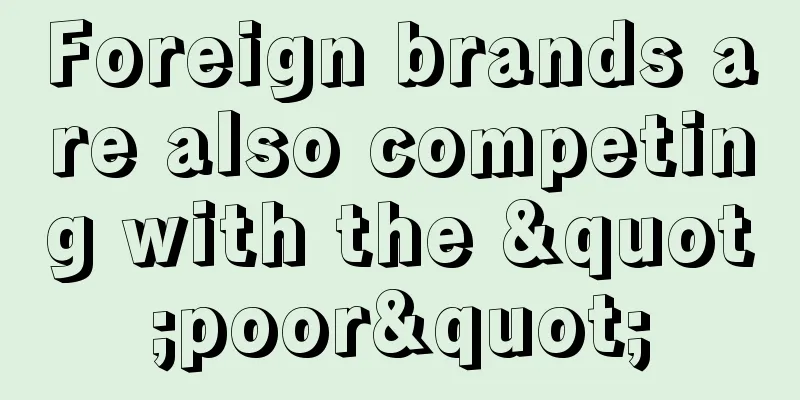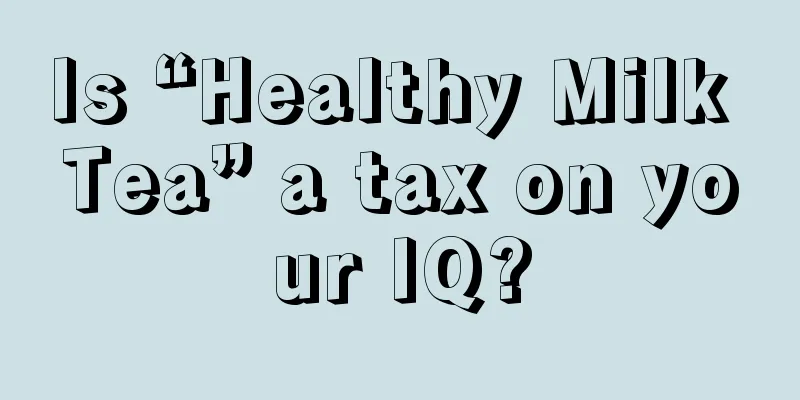Foreign brands are also competing with the "poor"

“It’s that easy to win back consumers’ hearts.” Which restaurant business has not been affected by the popular “poor guy’s meal”? No one expected that this term, which became popular during the epidemic period in 2022 - originally just a self-deprecating meme among young people who discovered the low-priced meals around them, has now become a real operating indicator and wealth code for major catering companies, especially well-known chain catering companies. How outrageous was it at one point? Sam's Club, the main base for purchasing daily necessities for middle-class families in China, has a "poor man's three-piece set" of 21.9 yuan for 1.59kg eggs, 23.9 yuan for 7 bagels, and 59.8 yuan for 16 Swiss rolls. New Rongji, a high-end Chinese restaurant chain with an average price of over a thousand yuan per person, launched a single-person lunch set for weekdays at 398 yuan, which has attracted a large number of young people to arrange a "poor man's strategy" on how to eat too much. Wagas, which costs 70 or 80 yuan for a bowl of salad, has become a "poor man's must-have" for sophisticated white-collar workers after being sold at half the price on Douyin and other group purchases. It is not important to discuss whether there are real or fake poor people here. The trend is indeed that from high-end to mid-range, and then to affordable restaurants, they are all using price cuts to attract traffic. In May, the two major fast food giants KFC and McDonald's had a battle for the "poor". First, KFC launched a special 9.9 yuan burger, including the original chicken burger, spicy chicken leg burger, New Orleans grilled chicken leg burger and Old Beijing chicken roll. Then, McDonald's immediately followed suit and launched a daily "10 yuan burger" burger and drink two-piece set for several consecutive weeks, which was even more cost-effective. Image source: KFC, McDonald's official Weibo Of course, it’s not just KFC and McDonald’s that are offering discounts. Starting in mid-May, Dicos also launched a “9.9 yuan a day” event that lasted for half a month, offering a random combination of burgers and drinks. Earlier, last summer, Burger King launched the “King’s Day on Wednesday” event, offering a random combination of burgers and snacks/drinks for 9.9 yuan. What is even more surprising is that on Weibo’s hot searches, there is an entry “The 9.9 yuan trend has finally reached Starbucks”. In the face of the price war launched by Luckin Coffee and Coodi, even Starbucks, which has always been dignified, can’t stand it? Why are the foreign chain restaurant giants that have entered China for many years now starting to rob the "poor"? 1. Foreign brands are the ones who know the truthTo be honest, it is not accurate to describe these brands as "starting to get involved". After all, from KFC's Crazy Thursdays to McDonald's Free-to-Serve, they can be regarded as the pioneers of the "poor guy's meal" that have gone viral. The fact that they have started to get involved points more to the fact that they have entered the low-price war in the catering industry with a more localized attitude. Specifically, they have solved the workers' need for a full meal at an extremely low price. KFC's "Crazy Thursday" was a pioneer. KFC first launched the event in 2018 and invited celebrities to endorse it. Most of the products were chicken nuggets, French fries and hamburgers priced at 9.9 yuan, but it did not cause much response. Then, in 2021, by chance, the "V Me 50" Crazy Thursday meme literature began to emerge on the Internet. KFC seized the hot spot in time and put it into operation, such as holding the "Crazy Thursday Literary Competition" in the live broadcast room. Until today, with the dual effects of luck and hard work, it has become an unshakable symbol in the "poor guy's meal" world. Of course, luck plays a larger role in this. Pizza Hut, also owned by Yum China, also has the "Screaming Wednesday" event, but its popularity and reach are much weaker. McDonald's "Add to Favorites" was launched in 2019 and was initially priced at 12 yuan. The McChicken Burger, Double Cheeseburger and Chicken McNuggets, etc., were paired with beverages/Sun Hung Kai. Once launched, it captured the minds of "McGate" people. Now, from the 9.9 yuan special burger coupon to the 10 yuan two-piece-option event, the price bottom line of the traditional "poor man's meal" of the above two companies has been refreshed. This is also a concrete manifestation of their entry into the current popular price war. However, when we are attracted by the special price packages, it is easy to overlook that McDonald's has been raising prices over the years. A typical example is McDonald's free-to-serve, which was launched in 2019 at a price of 12 yuan, raised to 12.9 yuan in 2021, and adjusted again to 13.9 yuan at the beginning of last year. According to incomplete statistics, McDonald's and KFC have raised prices no less than three times in the past three years. KFC alone has had three consecutive price increases in 2021, mostly 0.5 to 2 yuan for hamburgers and meal sets, and McDonald's meal sets have even increased by 5 or 6 yuan. McDonald's most recent price increase was at the end of last year, when nearly 90% of its hamburger snacks would increase by 0.5 yuan, and the McChicken meal would increase by 2 yuan. In general, the average increase is about 3%. The increase in raw material and labor operating costs is the direct cause, and considering inflation and the difficult environment in the past three years, these price increases seem "understandable". But the question is, for Ken & Mcdonald, which has been in China for more than 30 years, how long can the continuous price increases of hamburgers and French fries maintain their competitiveness amid competition from developed local noodle and fast food categories? On the other hand, the rise of similar local fast food brands such as Tustin and Wallace is also further exacerbating the anxiety of McDonald's. It is true that in terms of brand recognition and scale, Tustin and Wallace cannot compete head-on with McDonald's, but the two rising from the low-tier markets are also territories that McDonald's needs to continuously cultivate. McDonald's China CEO Zhang Jiayin once said that in addition to first- and second-tier cities, the sinking market will be the key deployment area for McDonald's. Under the influence of various external factors, KFC's 9.9 yuan special burger coupon and McDonald's 10 yuan two-item coupon are essentially no different from their successful "Crazy Thursday" and "Pair Your Choice" campaigns. The occasional "small favors" given to consumers in addition to the not-so-cheap regular prices are an important means of maintaining brand loyalty. We can also see clues of this tactic at IKEA. Recently, "I'm OK again" is the real reaction of consumers to IKEA on social media. In the past two years, IKEA, which has often announced price increases due to increased raw material and transportation costs, has frequently suffered a setback in reputation. Recently, IKEA, which has entered the "May 23rd to June 26th" discount period, has launched a big discount event with hundreds of classic products at a minimum of 50% off. Many people have rushed to buy them on social platforms such as Xiaohongshu. However, more importantly, IKEA catering has also started to offer "poor man's meal packages". From May 10 to May 31, IKEA launched a "half-price Friday" event, with meal packages such as Italian cheese bolognese and grilled sausage platter sold at half price, and the most affordable Swedish meatball rice was only 9.9 yuan. It’s really that easy to win back consumers’ hearts. 2. How long can the Poor Man’s Package last?It should be noted that the Poor Man's Meal is not only popular in China. Recently, McDonald's announced the launch of a $5 meal in the United States, which includes a McDonald's cheeseburger/chicken sandwich, small fries, a drink and a four-piece McNuggets. The promotion will last for one month. This is also a choice McDonald's was forced to make in response to the decline in store traffic and the increasing unwillingness of consumers to pay high prices for dining out. Obviously, the companies have sacrificed profits for such extremely low prices. For example, in the first quarter of this year, the operating profit margins of KFC and Pizza Hut under Yum China both declined, with KFC down 1.9% and Pizza Hut down 1% year-on-year. The reason is that they increased the cost-effective products to promote customer flow growth. Therefore, giants such as KFC and McDonald's often only dare to launch such activities for a limited time. In other words, 9.9 yuan is really unsustainable. In this process, the fierce competition in the catering industry makes this trend even more tragic. Last year, after McDonald's announced a one-yuan price increase for its free-to-eat buffet, Burger King was still playing a meme on Weibo, continuing its "9.9 yuan Wednesday King's Day, free-to-eat buffet" campaign launched last year. Burger King has been "suicidal" in its promotions. In addition to its own 9.9 yuan special offer, it has also launched a cooperative campaign of two burgers for 9.9 yuan on platforms such as Meituan, which once made many "McGate" believers defect to "HanGate". In the United States, shortly after McDonald's recently launched a $5 meal deal, Burger King also announced that it would follow suit and launch a $5 deal. In addition, in May, Dicos also followed suit and launched a "9.9 yuan a day" burger and snack combo that lasted for half a month. Image source: Burger King, Dicos official Weibo The volume is endless. The catering industry is too difficult. There are many practitioners, and the entry threshold is not high. It is very easy for companies with similar positioning to enter the same river, not to mention these foreign fast food restaurants that are almost the same. Nanchengxiang, a community restaurant chain that has become an Internet celebrity, launched an affordable hotpot last year. The all-you-can-eat vegan hotpot costs 22.9 yuan. It is the leader of the "poor man's meal package" in the local catering industry and has quickly gained followers. New Retail Business Review noted that Haoshikou, a chain brand also positioned as a community restaurant, also launched the same self-service hot pot at its Zhichun Road store in Beijing, priced at 22.8 yuan, with more vegetable varieties than Nanchengxiang. In addition, compared with Nanchengxiang's 19.9 yuan per serving of meat, Haoshikou set the price at 16.8 yuan. Now, as Xiabu Xiabu has lowered the price of its set meals and returned to the weekday lunch price of 40 to 50 yuan, the gap with Nanchengxiang has narrowed, and the latter, which has been lying in the comfort zone of cost-effectiveness, has come under comparative pressure. When we look back, the 9.9 yuan trend first started from the coffee industry, led by Cudi, Luckin Coffee responded, and was forced to continue until this year, when Starbucks, which had been holding on, was also dragged into it. It is a bit difficult for Starbucks to lower its price from 30 to 40 yuan per cup to 9.9 yuan per cup all of a sudden. Therefore, it needs to add various discounts from platforms such as Ele.me to achieve such a low price. But now, ordinary users will be continuously fed with a large number of coupons for two cups at 39.9 yuan and three cups at 49.9 yuan in the Starbucks mini program. Image source: Starbucks Mini Program Before that, Starbucks cancelled its 15-yuan breakfast promotion. Starbucks was in a dilemma. As a result, even the major player Luckin Coffee can no longer hold on. Since the beginning of this year, many consumers have found that Luckin Coffee’s 9.9 yuan coffee discount has been shrinking. On the one hand, the coupons that were originally valid for almost all products are now only valid for designated products, and the rest have returned to the 20 yuan price. On the other hand, there are also restrictions on store usage. Luckin's performance speaks for itself. After achieving its first profit in the first quarter of 2022, Luckin entered a loss-making mode again in the first quarter of this year, just two years later, with a net profit loss of 10 million yuan, while in the same period last year, the figure was 680 million yuan in net profit. In addition to Luckin Coffee, Tims, Manner and others that once participated in the 9.9 yuan price war have now quietly taken down their 9.9 yuan activities. As for Coodi, who threatened to continue, only its franchisees know how hard it is. I can't help but think of the various subsidy wars in the past few years, including takeout and taxi-hailing. After burning out, there is nothing. The characteristics of the catering industry, where successive generations of people are replaced by the old ones, make this situation less likely to happen, but it is not a good thing after all. The trend of poor man’s meal packages continues, and consumers do like it, but can catering companies ensure that they will not reap the rewards by raising prices recklessly in the future? Author: Bei Hai; Editor: Ge Weiwei Source: New Retail Business Review |
<<: Prada signed Jia Ling. Is it for traffic or brand concept?
>>: Job hopping and career development
Recommend
How to submit an action plan to Amazon? What should I pay attention to?
Amazon is a well-known cross-border e-commerce pla...
3,000 stores have been digitized, and the user scale has exceeded 20 million. What is the advantage of the private domain of "China's Shoe King" Aokang?
In the digital age, how does the traditional shoe ...
How is the etsy platform? What are its disadvantages?
Although Etsy has closed the entry channel for mai...
How does Shopee ship goods without a source? What are the shipping steps?
Merchants without sources actually have stores on ...
“Maixue” went viral: a carefully planned marketing feast
Under the magnifying glass of social media, Mai Li...
My boss is such a rebellious son. My article has a 50% popularity rate and you still say it's a waste of money?
No matter which brand, they will encounter the dil...
The cost of advertising on Xiaohongshu is getting higher and higher. How to grow in a muscle-like way?
It is increasingly difficult for merchants to star...
With a million followers in 7 days, is “profiteering” also the secret to internet celebrity traffic?
A live broadcaster who sells expiring food product...
With 50 million members and member contributions accounting for over 50%, how does Dicos operate its private domain?
"Private domain" is a hot operation conc...
Is eBay cross-border e-commerce legal? How much is the annual fee?
In the cross-border e-commerce industry, eBay, as ...
Can Amazon advertise adult products? How to operate?
Many people will open stores on Amazon. In additio...
Top internet celebrity "Wang Ma" with millions of fans fell from grace. Was her success and failure due to being a worker?
In recent days, the top internet celebrity "W...
Crazy Xiao Yangge is gone, top internet celebrities and MCNs are competing for the short drama cake
This article deeply explores the current competiti...
How is DHgate.com's cross-border e-commerce business? How can we do it well?
There are still many merchants engaged in cross-bo...
Tik Tok Onslaught Game
The author of this article talks about the prospec...









